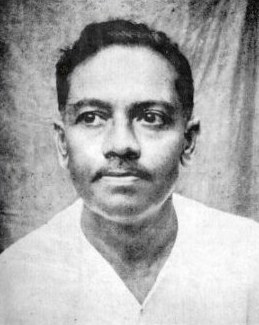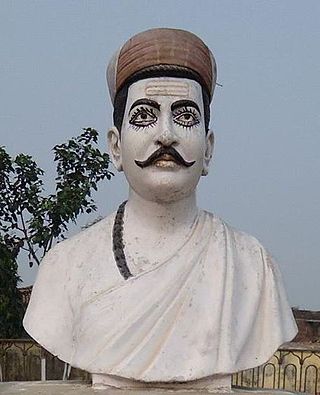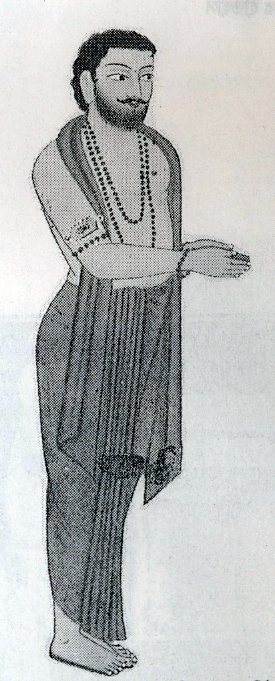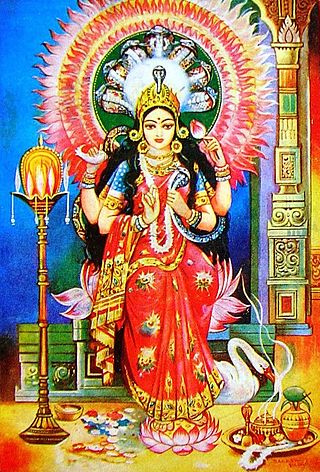Related Research Articles

Chaitanya Mahaprabhu, born Vishvambhara Mishra, was a 15th-century Indian Hindu saint from Bengal who was the founder of Gaudiya Vaishnavism, which considers him to be an incarnation of Krishna.

The music of West Bengal includes multiple indigenous musical genres such as Baul, Ramprasadi, Bishnupuri Classical, Kirtan, Shyama Sangeet, Rabindra Sangeet, Nazrul Geeti, Dwijendrageeti, Prabhat Samgiita, Agamani-Vijaya, Patua Sangeet, Gambhira, Bhatiali, Bhawaiya, Bengali Rock.

Jibanananda Das was a Bengali poet, writer, novelist and essayist in the Bengali language. Popularly called "Rupashi Banglar Kabi'', Das is the most read poet after Rabindranath Tagore and Kazi Nazrul Islam in Bangladesh and West Bengal. While not particularly well recognised during his lifetime, today Das is acknowledged as one of the greatest poets in the Bengali language.

Vidyapati, also known by the sobriquet Maithil Kavi Kokil, was a Maithili and Sanskrit polymath-poet-saint, playwright, composer, biographer, philosopher, law-theorist, writer, courtier and royal priest. He was a devotee of Shiva, but also wrote love songs and devotional Vaishnava songs. He had knowledge of, and composed works in Sanskrit, Prakrit, Apabhramsha and Maithili.

Behula is a protagonist in the Manasamangal genre of Assamese and Bengali medieval epics. A number of works belonging to this genre were written between the thirteenth and eighteenth centuries. Though the religious purpose of these works is to eulogise the Hindu goddess Manasa, these works are more well known for depicting the love story of Behula and her husband Lakhindar.

Rāmprasād Sen was a Hindu Shakta poet and saint of 18th-century Bengal. His bhakti poems, known as Ramprasadi, are still popular in Bengal—they are usually addressed to the Hindu goddess Kali and written in Bengali. Stories of Ramprasad's life typically include legends and myths mixed with biographical details.

Kamalakanta Bhattacharya, also known as Sadhaka Kamalakanta, was a Bengali Shakta poet and yogi of India of the late 18th century. He is often considered to have followed the example of Ramprasad, both in his poetry and in his lifestyle.

Tarapith is a town and Hindu pilgrimage site located in Rampurhat subdivision of Birbhum district of the Indian state of West Bengal. The town is particularly known for its Tantric temple and its adjoining Hindu crematory ground. The Tantric Hindu temple is dedicated to the goddess Tara.

Mangal-Kāvya is a group of Bengali religious texts, composed more or less between 13th and 18th centuries, notably consisting of narratives of indigenous deities of rural Bengal in the social scenario of the Middle Ages. The Mangal-Kāvyas usually give prominence to a particular deity amalgamated with a Vedic or Hindu mythological god and the narratives are usually written in the form of verses.
Govindadasa was a Bengali Vaishnava poet known for his body of devotional songs addressed to Krishna. Living in an atmosphere of Krishna-bhakti preached by Sri Chaitanya (1486–1533), he composed extensively on the Radha-Krishna love legend. He is also known as Govindadasa Kaviraja.

Manasa is a Hindu goddess of snakes. She is worshipped mainly in Bihar, Bengal, Jharkhand, South Assam and other parts of northeastern India and in Uttarakhand, chiefly for the prevention and cure of snakebite, and also for fertility and prosperity. In Hinduism, Manasa is the sister of Shesha and Vasuki, king of Nāgas (serpents), and wife of sage Jaratkaru. She is the mother of the sage Astika. She is also known as Vishahari, Nityā (eternal) and Padmavati.

Shyama Sangeet is a genre of Bengali devotional songs dedicated to the Hindu goddess Shyama or Kali which is a form of supreme universal mother-goddess Durga or parvati. It is also known as Shaktagiti or Durgastuti.
Bipradas Pipilai was a 15th-century poet. He was the son of Mukunda Pipilai, the family hailed from Baduria-Batagram in 24 Parganas, now in the Indian state of West Bengal.

Kali or Kalika is a major Hindu goddess associated with time, change, creation, power, destruction and death in Shaktism. Kali is the first of the ten Mahavidyas in the Hindu tantric tradition.

Manasamangal Kāvya is recognized as the oldest of the Bengali Mangal-Kāvyas, chronicling the establishment of the snake-goddess Manasa's worship in Bengal. Initially, Manasa was worshipped by the Dravidians, who hoped she would safeguard them from snake-related dangers. The goddess holds alternative names such as Bisahari, Janguli, and Padmavati.
Culture of Birbhum refers to the culture of Birbhum district in the Indian state of West Bengal.

Kali Puja, also known as Shyama Puja or Mahanisha Puja, is a festival originating from the Indian subcontinent, dedicated to the Hindu goddess Kali. It is celebrated on the new moon day of the Hindu calendar month of Ashwayuja or Kartika. The festival is especially popular in the region of West Bengal, and other places like Mithila and Anga of Bihar, Jharkhand, Odisha, Assam, and Tripura, as well as the town of Titwala in Maharashtra, along with the neighbouring country of Bangladesh.

Shashthi or Shashti is a Hindu goddess, venerated in Nepal and India as the benefactor and protector of children. She is also the deity of vegetation and reproduction and is believed to bestow children and assist during childbirth. She is often pictured as a motherly figure, riding a cat and nursing one or more infants. She is symbolically represented in a variety of forms, including an earthenware pitcher, a banyan tree or part of it or a red stone beneath such a tree; outdoor spaces termed shashthitala are also consecrated for her worship. The worship of Shashthi is prescribed to occur on the sixth day of each lunar month of the Hindu calendar as well as on the sixth day after a child's birth. Barren women desiring to conceive and mothers seeking to ensure the protection of their children will worship Shashthi and request her blessings and aid. She is especially venerated in eastern India.

Bamakhyapa, born Bamacharan Chattopadhyay, was an Indian Hindu saint who resided in Tarapith and whose shrine is also located in the vicinity of the Tara temple in Birbhum. He was born at Atla village in the Rampurhat subdivision of the Birbhum district.
Baidya or Vaidya is a Bengali Hindu community located in the Bengal region of Indian subcontinent. A caste (jāti) of Ayurvedic physicians, the Baidyas have long had pre-eminence in society alongside Brahmins and Kayasthas. In the colonial era, the Bhadraloks were drawn primarily, but not exclusively, from these three upper castes, who continue to maintain a collective hegemony in West Bengal.
References
- ↑ Sengupta, Nitish K. (2011). Land of Two Rivers: A History of Bengal from the Mahabharata to Mujib. Penguin Books India. p. 104. ISBN 978-0-14-341678-4.
- ↑ Seabrook, Jeremy (2001). Freedom Unfinished: Fundamentalism and Popular Resistance in Bangladesh Today. Zed Books. p. 26. ISBN 978-1-85649-908-8.
- 1 2 3 Ahmed, Wakil. "Vijay Gupta". Banglapedia. Retrieved 20 March 2020.
- ↑ Smith, William L. (1980). The One-eyed Goddess: A Study of the Manasā Maṅgal. Almqvist & Wiksell International. p. 35. ISBN 978-91-22-00408-0.
Bijay Gupta, a Baidya by caste, was from the village of Phullaśrī in the Barisal district of East Bengal. He is the most popular of the East Bengali poets and like Ketakādās, editions of his Manasa poem are numerous and permanently in print.
- ↑ "Manasha Devi, the relentless fighter". Daily Sun. Retrieved 20 March 2020.
- ↑ Chaudhury, Sushil (2016). Trade, Politics and Society: The Indian Milieu in the Early Modern Era. Taylor & Francis. p. 308. ISBN 978-1-351-99728-7.